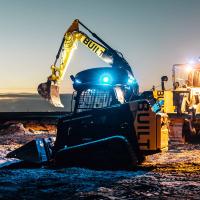Lung cancer is one of the deadliest diseases in existence, in part because it’s difficult to detect early. A lung biopsy procedure can be invasive, causing some patients irreparable complications. And far too often, once a doctor performs a lung biopsy to check for the disease, it has already reached an advanced state.
When it comes to a lung cancer diagnosis, time is of the essence. Yet until recently, doctors haven’t had many ways to safely and accurately perform an early lung biopsy, when the abnormal tissue growth is still very small. Intuitive‘s robotic-assisted solution, known as the Ion™ endoluminal system, is helping doctors reach nodules in a minimally invasive way, giving them the chance to detect cancer sooner.
The Difficulties of Diagnosing Lung Cancer
Lung cancer is the biggest cancer killer in men and women today, with approximately 200,000 diagnoses and 150,000 deaths annually. Each year, it kills more people than colon, breast, and prostate cancers combined.
Traditionally, a lung biopsy is conducted through a manual bronchoscopy. In this procedure, a doctor places a bronchoscope, a flexible tube with a camera and light attached, into the lung airways to find the potentially cancerous tissue. They then insert other instruments into that tube to retrieve a tissue sample.
While it’s often a doctor’s best hope at diagnosing lung cancer, manual bronchoscopy is limited in reach and precision because the tube is thick and inflexible. Manual bronchoscopy yields a diagnosis in about 60% of cases, meaning the results are often inconclusive.
The human lung consists of intricate tissue and a vast network of narrow and delicate airways, so obtaining a decisive biopsy result can require invasive and complicated surgery. For example, in one surgical method, doctors cut a patient between the ribs, front to back, which may leave them with permanent nerve damage and pain lasting months or even years. For these reasons, doctors can be hesitant to perform a surgical biopsy.
Lung cancer is fast-moving – the sooner the medical intervention, the better. “Seventy-five percent of patients are found when they’re at stage three or four, where we can’t do a surgery to cure them,” Dr. Michael Pritchett, a pulmonologist, explains. “We need something that changes the status quo, something that we can get out to smaller lesions with confidence and safely biopsy them. That’s where robotics comes into play.”
Previously, medical technology did not allow doctors to keep pace with this deadly disease. With the Ion platform, they may be able to get ahead of it and give patients a fighting chance.
New Hope for Lung Cancer Patients
Intuitive is a global leader in minimally invasive, robotic-assisted medical technology. The company has designed an innovative surgical system that is more precise, more stable, and able to reach further into the lungs to retrieve samples. The robotic-assisted endoluminal system can help pulmonologists retrieve tissue that aids in diagnosis, and an early study at one hospital showed the ability to obtain a diagnosis nearly 80% of the time.
“Ion is a minimally-invasive robotic platform that allows me to take this steerable catheter and go far out into the periphery of the lung, where most of these lung cancers are,” Dr. Pritchett describes. “I can angle it up to 180 degrees and see where I’m going at all times with the camera… I also have GPS built in, so it’s like driving to somebody’s house with Google Maps and you just follow the directions right to the lesion.”
It’s like driving to somebody’s house with Google Maps and you just follow the directions right to the lesion.
Dr. Michael Pritchett
The process begins with doctors using a CT scan of a patient’s lungs to generate 3D “airway trees” to identify a target for biopsy and create a pre-planned path to the nodule. During the actual procedure, doctors use Ion’s controller to navigate along this path, maneuvering the catheter in any direction, through tight channels and angles, to any of the 18 segments of the lung. All the while, doctors have real-time vision of the airway.
After reaching the nodule, the catheter locks in place so that Ion’s custom-designed, Flexision™ biopsy needle can retrieve the sample. The precision of this technology allows doctors to reach areas of the lung that were previously difficult to navigate. They’re now able to remove samples to help diagnose patients without invasive surgery.
This has the potential to expedite diagnosis, which could improve a patient’s chance of survival.
This has the potential to expedite diagnosis, which could improve a patient’s chance of survival by hastening an appropriate treatment plan.
Dr. Pritchett was the first practitioner to use Ion and provided feedback to Intuitive’s engineers during its development. One of his patients, Doug Richardson, previously had a lung biopsy procedure that was inconclusive. Richardson was scheduled to have a traditional surgical biopsy when his granddaughter met Dr. Pritchett, who ended up using Ion to perform his biopsy.
“If Doug would have had that (traditional) surgery, his recovery would have been long and slow… He likely would have been in the hospital for four to five days. It would have been weeks before he was able to lift anything as heavy as a carton of milk. With (the Ion) procedure, he went home the same day,” Dr. Pritchett says.
Because of the Ion system, Richardson is well poised for the battle against lung cancer in a way that patients before him could’ve only dreamt of. Intuitive’s platform has the potential to improve lung cancer diagnoses through early biopsies, and give doctors the hope of improving patient outcomes.
Financial Disclosure
Drs. Pritchett and Herrera have received compensation from Intuitive for consulting and/or educational services.
The material that is presented in this video represents the views and opinions of independent physicians based on their practice and personal experience using the Ion Endoluminal System. The data that will be presented is single physician experiences. The results may or may not be reproducible and are not generalizable.
Ion is for sale in the U.S.
Outside of the U.S., Ion is not CE Marked and not for human use. Ion cannot be placed on the market or put into service. Ion may not have regulatory approvals in all markets. Please check with your local Intuitive representative.
Important Safety Information
Risks associated with bronchoscopy through an endotracheal tube and under general anesthesia are infrequent and typically minor, and may include but are not limited to: sore throat, hoarseness, respiratory complications including dyspnea or hypoxemia, airway injury, bronchospasm, laryngospasm, fever, hemoptysis, chest or lung infection including pneumonia, lung abscess or an adverse reaction to anesthesia. Although rare, the following complications may also occur: bleeding, pneumothorax (collapsed lung), cardiac related complications, respiratory failure, air embolism, or death. As with other medical procedures, there may be additional risks associated with the use of general anesthesia and/or endotracheal intubation which are not listed above; you should consult a health care professional regarding these and other potential risks.
Procedures using the Ion Endoluminal System may be associated with longer procedure and/or longer anesthesia time.
Ion Endoluminal System
The Ion Endoluminal System (Model IF1000) assists the user in navigating a catheter and endoscopic tools in the pulmonary tract using endoscopic visualization of the tracheobronchial tree for diagnostic and therapeutic procedures. The Ion Endoluminal System enables fiducial marker placement. It does not make a diagnosis and is not for pediatric use.
The Flexision Biopsy Needle is used with the Ion Endoluminal System to biopsy tissue from a target area in the lung.
The PlanPoint Software uses patient CT scans to create a 3D plan of the lung and navigation pathways for use with the Ion Endoluminal System.
References
- Lung cancer is the largest cancer killer – American Cancer Society. Key Statistics for Lung Cancer. https://www.cancer.org/cancer/lung-cancer/about/key-statistics.html.
- 75% patients found at stage 3 or 4 – Walters S, et al. 2013. Lung cancer survival and stage at diagnosis in Australia, Canada, Denmark, Norway, Sweden and the UK: a population-based study, 2004–2007. Thorax. 68, 551–564.
In addition, approximately 79% of cancer cases are diagnosed at the regional or distant stage according to the SEER 18 2010–2016, All Races, Both Sexes by SEER Summary Stage 2000 data. – https://seer.cancer.gov/statfacts/html/lungb.html. - 180 degrees and GPS – Results based on internal testing.
- Procedure time – Typical case times using Ion include the following: Median procedure time: 47 min (IQR: 35-67min); Median time to EBUS visualization: 11 min (IQR: 7-18 min); Navigation time: approximately 5 min (IQR: 3-10 min). Folch, E.E., et. al. A Prospective, Multi-Center Evaluation of the Clinical Utility of the Ion Endoluminal System -Experience Using a Robotic-Assisted Bronchoscope System with Shape-Sensing Technology. A2719-A2719. 10.1164/ajrccm conference.2020.201.1_MeetingAbstracts.A2719.
- Held itself in that position – Comparisons of precision and stability are relative to manual techniques. Stability is enabled by fiber optic sensing technology which maintains active robotic control of catheter position and corrects unwanted tip deflection. Results based on internal testing.
- Return home the same day / Diagnostic yield trend – With regards to length of stay: most subjects (86.2%) are discharged the same day of the procedure. (mean length of stay: 5.2 +/- 0.6 hr, range: 4.2, 6.4 hr). Four (4) subjects (13.8%) had overnight hospital admissions wtih total length of stay of 24.9 +/- 3 hr (range: 21.2-28.5 hr); one (1) subject was admitted for observation due to a complication while the other three (3) were pre-planned admissions.) Fielding D, I, K, Bashirzadeh F, Son J, H, Todman M, Chin A, Tan L, Steinke K, Windsor M, N, Sung A, W: First Human Use of a New Robotic-Assisted Fiber Optic Sensing Navigation System for Small Peripheral Pulmonary Nodules. Respiration 2019;98:142-150. doi: 10.1159/000498951. In addition, internal data on file.
Trademark Notice
Product and brand names/logos are trademarks or registered trademarks of Intuitive Surgical or their respective owner. See www.intuitive.com/trademarks.


